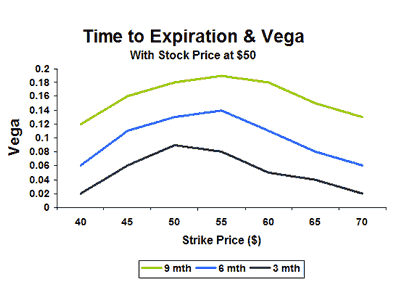
Vega changes when there are large price movements (increased volatility) in the underlying asset, and falls as the option approaches expiration. Vega is one of a group of Options Greeks used in options analysis, and is the only one not represented by a Greek letter.
Volatility Changes
In simple terms, the options Greeks vega measures the risk of gain or loss resulting from changes in volatility.
Vega for all options is always a positive number because options increase in value when volatility increases and decrease in value when volatility declines. When position Vegas are generated, however, positive and negative signs appear. When you establish a position selling or buying an option, this will result in either a negative sign (for selling) or positive sign (for buying), and the position Vega will depend on net Vegas.
Vega is higher on options that have more distant expiration dates. However, since those options are also more expensive in dollar terms, the vega is actually higher on options with closer expiration if we look at percentage gain or loss.
Options tend to be more expensive when volatility is higher. Thus, whenever volatility goes up, the price of the option goes up and when volatility drops, the price of the option will also fall. Therefore, when calculating the new option price due to volatility changes, we add the vega when volatility goes up but subtract it when the volatility falls.

Vega Risk
The options Greeks vega is one of the most important risk metrics an option trader relies upon. It is used to gauge the portfolio’s overall sensitivity to changes in implied volatility, one of the largest risks the option traders faces. For example, a trader with $1 million of vega knows he will make or lose $1m dollars for every 1% change in implied volatility. Often, a decline in IV (also known as vega risk) will offset the impact of price gains in the underlying stock. This is how you can be correct on a stock's direction and still lose money on an options position.
Short premium positions like Iron Condors or Butterflies will be negatively impacted by an increase in implied volatility, which generally occurs with downside market moves. When entering Iron Condors or Butterflies, it makes sense to start with a slightly short delta bias. If the market stays flat or goes up, the short premium will come in and our position benefits. However, if the market goes down, the short vega position will go against us - this is where the short delta hedge will help.
Following the same logic, it makes sense to start vega positive trades like calendars slightly delta positive, in order to hedge potential IV decrease if the underlying goes up. It also makes sense to use vega positive strategies like calendars when IV is low and vega negative strategies like Iron Condors when IV is high.
List of positive vega strategies
- Long Call
- Long Put
- Long Straddle
- Long Strangle
- Long Calendar Spread
- Vertical Debit Spread
List of negative vega strategies
- Short Call
- Short Put
- Short Straddle
- Short Strangle
- Vertical Credit Spread
- Covered Call Write
- Covered Put Write
- Iron Condor
- Butterfly
Watch the video:
Related articles:
- The Options Greeks: Is It Greek To You?
- Options Trading Greeks: Theta For Time Decay
- Options Trading Greeks: Delta For Direction
- Options Trading Greeks: Gamma For Speed
- How We Made 23% on $QIHU Straddle in 4 Hours
Want to learn how to put the Options Greeks to work for you?





There are no comments to display.
Join the conversation
You can post now and register later. If you have an account, sign in now to post with your account.
Note: Your post will require moderator approval before it will be visible.